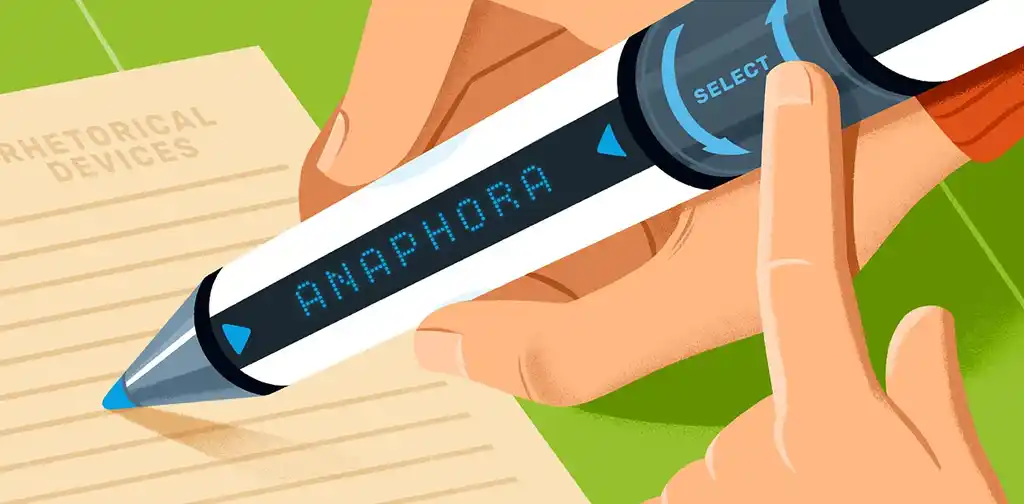Posted on Mar 07, 2023
What Is Polysyndeton? Repeating "And" for Emphasis
About the author
Reedsy's editorial team is a diverse group of industry experts devoted to helping authors write and publish beautiful books.
More about the Reedsy Editorial Team →Polysyndeton is a stylistic and rhetorical device that uses multiple coordinating conjunctions (e.g., 'and,' 'but') in close succession. It’s used in literature and everyday speech to create a list-like effect, slowing the pace of the sentence, adding emphasis and tension, or heightening emotion.
The term dates back to Ancient Greece, from where it gets its name: 'polysyndeton' consists of poly and syndeton, and simply means "multiple things bound together.” Grammarly might suggest that it’s a sign of poor writing, but polysyndeton can be found in the Bible, Shakespeare’s plays, and countless contemporary books and speeches, so let’s take a closer look at its function and effect.
Adding emphasis by repeating conjunctions
By repeating coordinating conjunctions (and, but, so, or, for, nor, yet), polysyndeton elongates a sentence, breaking up the rhythm and creating a tone of insistence. It creates emphasis, keeping readers engaged and bestowing importance to the items being listed. Basically, if you’re losing someone’s attention, polysyndeton can prick their ears up.
This device’s emphatic abilities make it an extremely popular choice of rhetorical device for speechwriters. In Barack Obama’s famous speech "A More Perfect Union," for example, he discusses every American’s responsibilities:
“And it means taking full responsibility for our own lives — by demanding more from our fathers, and spending more time with our children, and reading to them, and teaching them that while they may face challenges and discrimination in their own lives, they must never succumb to despair or cynicism; they must always believe that they can write their own destiny.” — Barack Obama, "A More Perfect Union"
With the repetition of ‘and’, this passage takes on a tone of intentional perseverance. Each statement builds on the one before, invoking every parent’s desire to give their children more. Compare this to a sentence using no conjunctions at all, the opposite of polysyndeton. This is known as ‘asyndeton,’ and it simply relies on commas:
“…by demanding more from our fathers, spending more time with our children, reading to them, teaching them that while they may face challenges…”
This reads like an ordinary list of boring tasks that makes no demands of its reader — it’s easy for them to stop paying attention, as it’s an ordinary list, in this case.
Note: Asyndeton can be impactful when few items are listed, like Caesar’s “I came, I saw, I conquered,” or Sylvia Plath’s “I am, I am, I am.” Both are short declarations that also result in emphasis, though they create it by omitting conjunctions and speeding up a sentence.

FREE RESOURCE
Rhetorical Device Cheatsheet
Improve your powers of persuasion by mastering these 35 devices.
Through repetition, polysyndeton allows the writer to escalate a sentence’s intensity. But in many cases, it can also be used to introduce change or a twist.
Repetition establishes a pattern that can be broken
In certain contexts, the repetition in polysyndeton helps writers set up how things have been, and then introduce a shift. Note how the example below uses repeated conjunctions to introduce a situation that has persisted for a while, then adds a break in the pattern with 'then,' showing that something is now different:
“Adam Trask grew up in grayness, and the curtains of his life were like dusty cobwebs, and his days a slow file of half-sorrows and sick dissatisfactions, and then, through Cathy, the glory came to him.” — John Steinbeck, East of Eden

This example uses polysyndeton to trace the dullness of Adam Trask’s early life, only to contrast them with the light that fills it when he meets a young woman named Cathy. The repeated ‘and’ shows just how long he has felt unhappy with his circumstances and how sorely Adam must have longed for a change. In a novel filled with Biblical references, the polysyndetic syntax of this sentence constitutes another nod to the Bible and its importance to the story.
📚 For more incredible writing by the same author, check out our list of the best Steinbeck books.
In a similar example, Jonathan Safran Foer sketches out the daily routine of a widow in mourning by using repetition:
“Every widow wakes one morning, perhaps after years of pure and unwavering grieving, to realize she slept a good night's sleep, and will be able to eat breakfast, and doesn't hear her husband's ghost all the time, but only some of the time.” — Jonathan Safran Foer, Everything Is Illuminated
This polysyndeton illustrates the devastation and repetitiveness of living with grief, but also suggests the release that change can bring. This example is particularly interesting because it presents a list of positive things like sleeping and eating, only to undercut them with 'but,' revealing the widow’s life is still clouded by her loss.
🖊️
Which contemporary author are you?
Find out which of today's greats is your writerly match. Takes one minute!
For such a simple device, you may be surprised by how emotional polysyndeton can make writing.
Repetition also expresses the slow release of tension
As well as showing change, polysyndeton can show the frustration unchanging situations can cause. Take these lines from Arthur Miller’s Death of a Salesman, spoken by Willy Loman, who has just lost his job as a traveling salesman. They’re uttered as we approach the play’s climax and come in great contrast to Willy’s refusal to acknowledge his failure up to this point:
“Funny, y’know? After all the highways, and the trains, and the appointments, and the years, you end up worth more dead than alive.” — Arthur Miller, Death of a Salesman
 Tragically — and beware of a major spoiler here — Willy’s observation that “you end up worth more dead than alive” foreshadows his plan to commit suicide, in hopes that his family can claim money from his life insurance.
Tragically — and beware of a major spoiler here — Willy’s observation that “you end up worth more dead than alive” foreshadows his plan to commit suicide, in hopes that his family can claim money from his life insurance.

FREE COURSE
How to Write Believable Dialogue
Master the art of dialogue in 10 five-minute lessons.
📚 Read more about the way Death of a Salesman unfolds in our post about the great tragic structure, Freytag's Pyramid.
It's how we speak: repeating ourselves, and drawing sentences out longer and longer, especially when our emotions are heightened.
Polysyndeton conveys overwhelming emotions
 When it appears at an emotional time, the effect polysyndeton has on a reader is similar to what you feel when a speaker’s voice breaks, and you suddenly hear all the feeling in their voice.
When it appears at an emotional time, the effect polysyndeton has on a reader is similar to what you feel when a speaker’s voice breaks, and you suddenly hear all the feeling in their voice.
In this extract from Sylvia Plath’s The Bell Jar, the narrator is overwhelmed in a moment of existential indecision:
“I saw my life branching out before me like the green fig tree in the story. [...] One fig was a husband and a happy home and children, and another fig was a famous poet and another fig was a brilliant professor, and another fig was Ee Gee, the amazing editor, and another fig was Europe and Africa and South America, and another fig was Constantin and Socrates and Attila and a pack of other lovers with queer names and offbeat professions, and another fig was an Olympic lady crew champion, and beyond and above these figs were many more figs I couldn't quite make out. I saw myself sitting in the crotch of this fig tree, starving to death, just because I couldn't make up my mind which of the figs I would choose.” —Sylvia Plath, The Bell Jar
This run-on sentence (with its constellation of ‘ands’) expresses the confusion, distress, and melancholy that overlap in the narrator’s mind. Compared to the text surrounding this passage, polysyndeton also helps mark this moment as important.
By elongating certain sentences, a writer can break up the rhythm of their writing. This can, in turn, open up space in the narrative for a pause of reflection.
It prolongs moments of reflection
A sentence that repeats ‘and’ or another coordinating conjunction multiple times in polysyndeton changes the flow of the writing. The syntax is broken up, like a car that starts and stops multiple times before it manages to run smoothly. (Solidarity with everyone who had to learn to use a clutch to drive stick.) The reader or listener has no choice but to pay attention to every word, so the lull in narrative progression provides an opportunity for reflection.
In this passage from Dickens’ Bleak House, the narrator observes a storm through a series of minute details:
“It was grand to see how the wind awoke, and bent the trees, and drove the rain before it like a cloud of smoke; and to hear the solemn thunder, and to see the lightning; and while thinking with awe of the tremendous powers by which our little lives are encompassed, to consider how beneficent they are, and how upon the smallest flower and leaf there was already a freshness poured from all this seeming rage, which seemed to make creation new again.” — Charles Dickens, Bleak House

These descriptive details all link up to create an impressionistic summation of a whole. This paragraph consists of a single, syntactically complex sentence, which slows down the speed and rhythm of the writing, magnifying the moment.
Though it’s a very simple rhetorical and literary device, we’ve seen that polysyndeton can be really powerful in literature, speechwriting, and even everyday speech. If you’re ready to learn about other devices that can power up your writing, head to our list of literary devices — or go straight to our guide on the types of irony. Tick tock, it’s learning o’clock!








